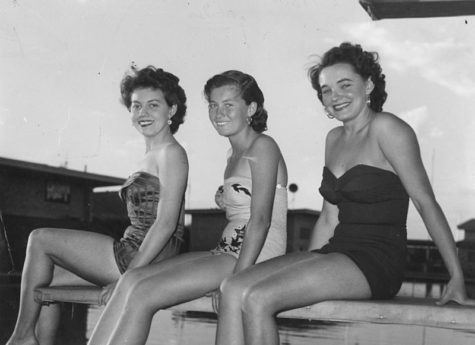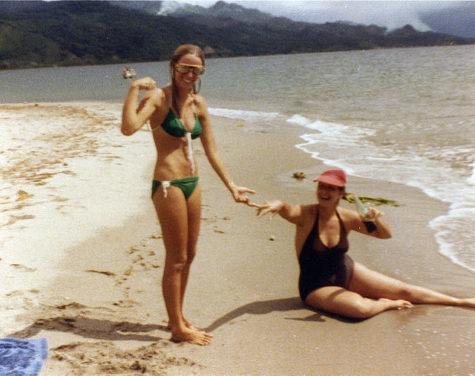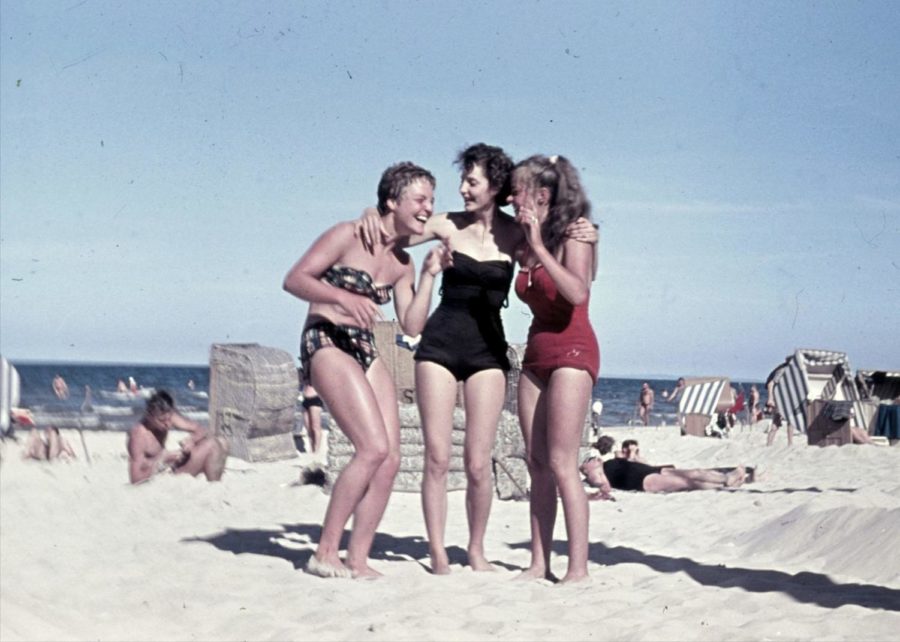Changes At Sea: The Evolution of the Modern Swimsuit, From 1800 To Today
Over the past century, the swimsuit has changed drastically. So how did the woolen bathing gowns of the 1800s get us to the bikinis of today?
A wave crashes on the beach, as hungry seagulls scour the sandy dunes for their next meal. The smell of salt and washed-up seaweed hangs in the air. This quintessential scene stays stagnant as the world around it ebbs and flows, even as the decades go by.
The people may change, but the sea never does.
Yet change amongst beachgoers is obvious – particularly in the ways that they dress. If one traveled a century back in time, they would clearly be out of place – the sailor-outfit bathing suits sported in 1923 are at great odds to the bikinis and speedos of 2023. So how did swimsuits and other beachwear in America evolve to this point?
In order to answer this question, we must look in the past, starting where the shakeup of swimsuit design first started: the 1800s.
The 1800s
During the 1800s, any passing mention of today’s swimwear would surely result in someone clasping their pearls in shock. Swimsuits were essential, yes, but modesty was key. Even a flash of an ankle was scandalous, despite the impracticality of covering yourself up in the water while trying to swim.

Men and women alike both covered themselves up in wool and flannel “bathing gowns.” The cold, water-logged materials made it difficult to tread the water safely, yet during this time beaches started their slow spike of popularity that would eventually make them incredibly important. Men’s bathing gowns typically consisted of a striped, red-and-white shirt and pants that bared the shoulders and came up to the knees. Flannel was the main material used for these swimsuits as many believed that the warmer fabric would do well in the colder sea. Modesty was emphasized, but not as heavily as it was with women’s bathing gowns.
Women’s bathing gowns were woolen and could weigh up to nine pounds once soaked in the frigid public water. The process of wearing these gowns was more elaborate than men’s, as special “bathing machines” littered public water places. In such carriages, women changed into their bathing gowns hidden from the presence of the opposite sex, to ensure that very little skin was shown at the end of the day. Modesty had been key up till this point in history, and it was essential to preserve it during the 1800s.
Overall, the 1800s served as an incredibly important period for swimsuits and beaches as it served as a turning point for the attitudes expressed towards beaches in general, as more and more people began to visit beaches recreationally often.
1900-1920s
Leave wool at the door. The roaring twenties are about to surface.
In the early 1900s, accessories from the late 1800s such as bathing caps and bathing shoes remained widely popular. Today, the descendants of the early bathing caps and shoes can be seen in water shoes and swimming caps, serving the same purpose as they did more than a century ago.
Water shoes protected beachgoers’ feet from shards of glass or other sharp objects that littered beaches at the time. Today, they serve a similar purpose, but are usually more popular amongst small children and in other water-based activities such as rafting. Now that more regulations have been put into place to ensure the cleanliness of beaches, more and more people are comfortable going barefoot.
Swimming caps then provided swimmers’ hair protection from the salty water and ensured that it wouldn’t be as much of a hassle afterwards to wash out.
With swimsuits, however, this is where the first cracks in the modest, and subsequently impractical, culture surrounding swimwear begin to form. Yet this was a lengthy process. In 1907, the record-shattering Australian swimmer Annette Kellerman was arrested for wearing a one piece bathing suit that ended in shorts above her knees. Despite Kellerman being thoroughly covered otherwise, her attire caused the uproar that led to her arrest.
In spite of Kellerman’s arrest, she is considered to be one of the most influential figures in the evolution of the woman’s swimsuit today. The design that she wore was notably more accommodating than wool, and got many swimsuit designers thinking about the possibilities of shorter swimsuits.
The 1920s, however, was when things really changed.
This period, especially in the United States, was hailed as the “roaring twenties.” Not knowing that the one of the greatest economic depressions in United States history would soon follow, the typical person of the 1920s was out having fun. The masses invested in entertainment, including participating in activities such as going to the beach. Throngs of people flocked to the beaches, many donning scandalous swimsuits popular in the 1920s. Swimsuit necklines got deeper and more easily worn for both men and women – the first cracks in the conservative culture surrounding beachwear.
1930-1950s
Where the 1900s-1920s were the beginning of the shakeup, the 1930s-1950s were the peak. Bikinis and Lastex, a stretchy, breathable material popularly used in waistbands of swimsuits, rose, bringing magnanimous changes to the swimsuit industry through it.
But before this all could fall into place, the Great Depression struck the United States in 1929 and the economy remained stagnant until 1941. Perhaps we never would have reached where we are today without the Great Depression – it was key to forming the modern bikini. Due to material rationing, swimsuits got smaller and subsequently bared more skin. This left many designers wondering – could these smaller swimsuits become more malleable?
And thus, the bikini was born.
In the late 1930s, near the end of the Great Depression, designer Jacques Helm put together a two-piece swimsuit that exposed the torso more than previous designs, but still covered the navel. This swimsuit was marketed as “the atom,” a nod towards the groundbreaking discovery of splitting the atomic nuclei a few years back. It was meant to represent modernity and the exciting prospect of the future.
Still, this swimsuit ended up being unpopular and relatively unheard of until 1946, when designer Louis Réard altered Helm’s design to make it tinier, coining the term “bikini” after the island Bikini Atoll that was used to test atomic bombs during World War II.
This swimsuit brought immeasurable havoc. It was compared to being “practically naked”; even Annette Kellerman would denounce the swimsuit, calling it ugly for how much it bared. For the majority of the 1940s, the bikini was banned from public beaches and although infamous, was rarely worn.

But as the fifties approached, the sentiment towards the scandalous attire started to die down. While it still elicited a negative response on boardwalks, more and more celebrities began to be spotted in them. Actresses such as Marilyn Monroe, Rita Hayworth, Ava Gardener and more sported the bikini — the winner of the first Miss World beauty pageant in 1951 was even crowned in a bikini!
Simultaneously, mens’ swimsuits rapidly lost fabric as well. The previous, widely accepted design of a deep-cut shirt and pants slowly became less commonplace as more and more men in the 1930s and 1940s took off their shirts. By the mid 1940s, the majority of men roamed shirtless on beaches, sporting shorts connected with a stretchy, white Lastex belt.
1960-1980s
These decades closely mirrored a trend that had been emerging for the majority of the twenty-first century. Swimsuits, like any other item of clothing, are closely tied to politics and fashion trends. For instance, if the governing party of a region is more conservative, conservative swimsuits are bound to be used. Similarly, if floral patterns are trending during one summer, there will undoubtedly be many floral swimsuits. The size of the swimsuit, for both men and women, wouldn’t change as drastically as it had in the past few decades during this time period, but it would undoubtedly undergo changes that reflected the time period it was from until it closely resembled our modern swimsuit.
In the 1960s, Peter Travis designed the first Speedo targeted towards men. It was popular amongst athletes later on due to how it minimized the water drag, but it also brought scandal akin to the bikini. The amount of skin that the Speedo showed, in comparison to the previous bloomers and boxers, was simply too much for the next few years. It wasn’t until the 1970s that attitudes began to change.
Meanwhile, with female swimsuits, trends started to emerge in the swimsuit designs that mirrored popular pop culture trends of the 1960s. Floral and ruffled swimwear was a common sight during this decade, and a common swimsuit of the time was a pair of shorts and a bikini top.
Every decade since then had similar results.

As women gained more rights and increased bodily autonomy in the 1970s through court cases such as Eisenstadt v. Baird and Roe v. Wade, and were able to have more freedom in the way they expressed themselves through their bodies, shorter swimsuits became more socially acceptable, and women increasingly began wearing them to public beaches. While there was still the slightest echo of modesty from previous decades, swimsuits of the 1970s most closely resembled swimsuits of today for the first time.
Yet the fashions of the 1980s did even more so. The 80’s are well known for their bold fashion statements and colors, and the swimsuit scene was no different. This was a decade marked with bold, hard cut lines in swimsuits and the addition of a single sporty white stripe on the side of mens’ beach shorts. One-pieces and bikinis grew increasingly popular and common on boardwalks. Still, the popular trends of the time managed to find themselves at the beach, with neon bathing suits and oversized sunglasses.
Thankfully for many swimmers, swimsuits in the 1980s were the most comfortable that they had ever been. This was due to the increase of materials such as nylon and lycra being used.
1990-Present Day
The past couple of decades have reached us to the current point of generally skin-baring and comfortable beachwear.
In the 1990s, swimsuits were small and usually sported bright colors and patterns. The tankini, the bikini’s close cousin, was also first introduced during this time. Essentially, the tankini is a tank top paired together with a bikini bottom.
After that, things stayed mostly the same for the next few years. Professional swimmers wearing Speedo and similar swimsuit brands won most awards due to the reduced swim drag, and by the 2010s, recycled plastics started to be used to make swimwear. This helped reduce the carbon footprint of both mens and womens’ swimwear drastically — it is estimated that swimwear that is made of recycled plastic stops up to 80% of its original estimated carbon footprint from being created.
The past century has been one of the most transformative in terms of modern swimwear, especially in European and American cultures. Yet one thing remains constant: the beach, and the people that simply enjoy it.
So the next time you slip on your favorite swimsuit and grab a drink to swim or simply just to hang out on the beach, remember the millions of people that came before. Their clothing may have looked a little different, but that’s fine.
The sea remains the same, regardless.
The past century has been one of the most transformative in terms of modern swimwear, especially in European and American cultures. Yet one thing remains constant: the beach, and the people that simply enjoy it.
Krisha Soni is an Editor-in-Chief for ‘The Science Survey.' She loves storytelling and journalistic pieces that bring their subject matter to life; in...

